In this article, you will learn what is a heat exchanger? Its diagram, parts, working, advantages, uses, and types of heat exchangers.
Also, you can also download the PDF file of this article at the end.
What is Heat Exchanger?
A heat exchanger is a system that is very important for transferring heat from one medium to another (liquid, vapor, or gas). Heat exchangers are used in both situations where cooling or heating is required.
According to the type of heat exchanger used, the heat transfer process can be carried out as gas to gas, liquid to gas, or liquid to liquid. Then it through a solid wall of high thermal conductivity, which prevents the mixing of liquids, or direct fluid contact.
A perfect example of them is found in I.C. engines in which a fluid (coolant) flows through the radiator coils and air flows through the coils, which cools the coolant and heats the incoming air.
We can find another example in a heat sink, in which heat is generated in a liquid medium by an electronic or mechanical device. Heat exchangers are widely used in space heaters, refrigeration, air conditioning, power stations (nuclear or hydroelectric), and chemical plants.
Read Also: Understand The Different Types of Air Conditioners [PDF]
How do Heat Exchangers work?
It is a device that allows heat from one liquid (liquid or gas) to be transferred to another liquid or gas without the two liquids mixing or coming into direct contact. They are used for cooling components that feature water to air, liquid-cooled, closed-loop systems.
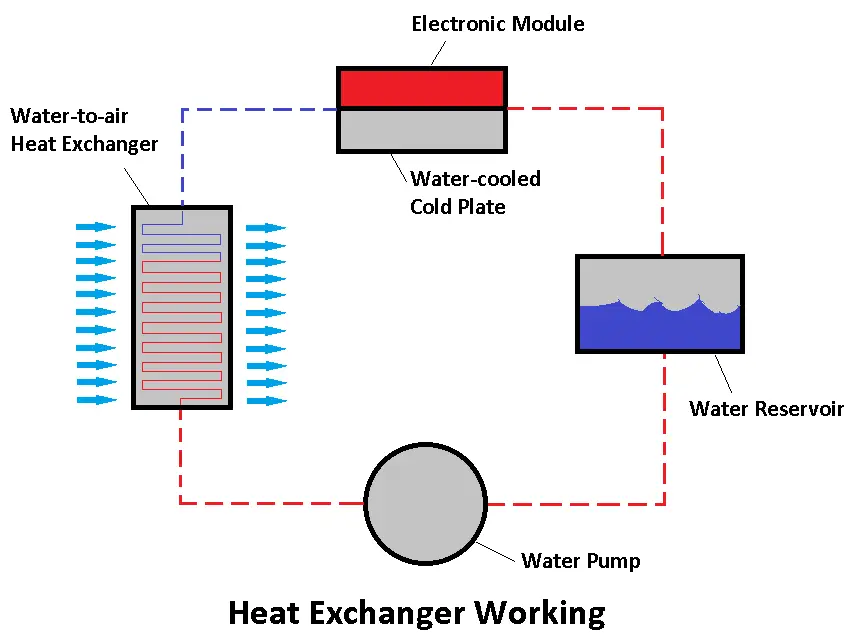
Closed-loop liquid cooling is defined as a cooling system that uses liquid as a coolant and uses a heat exchanger to remove heat from the coolant. The most commonly used coolants are water, deionized water, disrupted glycol, and water solutions.
In a liquid cooling loop, the coolant is pumped through a cold plate that is in contact with a heated integrated circuit. The heat released from the component is transferred to the surroundings in the heat exchanger, resulting in a lowering of the temperature of the coolant, which is pumped back into the heated integrated circuit.
Read Also: Different Types of Air Compressors [Explained with Pictures]
Parts of Heat Exchanger
Following are the parts of the heat exchanger:
- Tubes
- Tube sheet
- Tie rods
- Front headers
- Rear headers
- Cooling system
- Heat exchanger shell
- Heat exchanger baffle
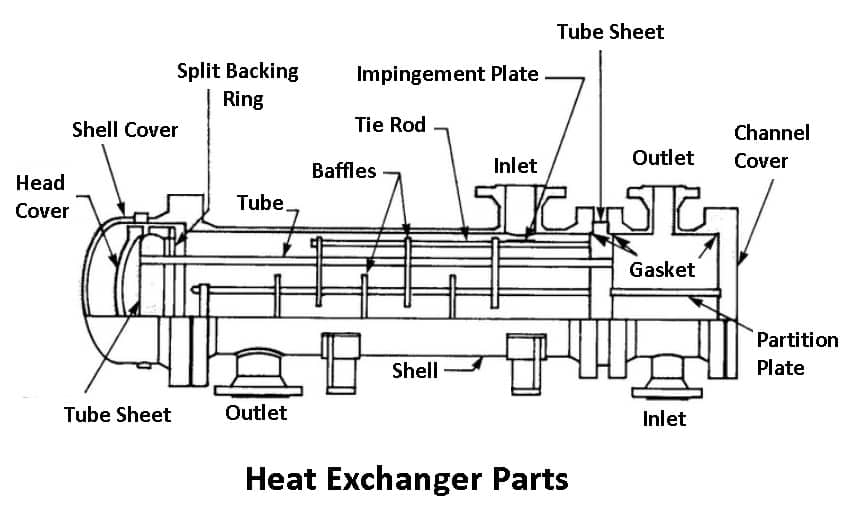
#1 Tubes
Tubes are the most essential part of the heat exchanger for transferring fluids. The type of tubing used is welded or seamless. Heat exchanger tubes are made in diameters of about 5/8 inch, between 3/4 inch and 1 inch.
#2 Tube Sheet
Tube sheets are helpful in supporting and separating the tubes. The tubes are attached to the tube sheet by hydraulic pressure or roller expansion. A tube sheet may be covered, which assists as a corrosion preventive and insulator.
#3 Tie Rods
Tie rods are also important in the heat exchanger. They are securely fitted to the end baffle at one end and to the tube sheet at the other end.
#4 Front Headers
Many heat exchanger front headers are available, including types A-B-C-D-N-Y. Since there are so many types, the use of the front header may vary according to the arrangement of flow pressure used, cost, ease of cleaning, and repair.
#5 Rear headers
The heat exchanger rear header includes L, M, and N-types are used if there is no high mechanical stress due to differential expansion and the shell side does not require cleaning. When there is a possibility of thermal expansion, a fixed rear header with bellows is used.
#6 Cooling System
The cooling system in the heat exchanger consists of fin fans, condensers, and chillers. Fin fans are performed to meet the need for blowing hot tubes to keep them cool efficiently.
The function of the condenser is to cool the objects until there is a phase change from gas to liquid. Chillers use water as their coolant and keep the water temperature low to cool the equipment without cooling the water.
#7 Heat Exchanger Shell
In the shell and tube type, one fluid flows inside the tubes, and another fluid flows inside the shell. These are nothing but large pressure vessels inside located bundles of pipes. It is the most expensive component among heat exchanger parts.
#8 Heat Exchanger Baffle
Baffles are placed inside the shell to supply higher heat transfer rates, increasing flow turbulence. Plus, these heat exchanger parts help to support the tubes and reduce problems caused by vibration.
Free PDF: What are the main types of Rolling Mills? [Working Explained]
Types of Heat Exchangers
Following are the types of heat exchangers used for almost all purposes:
- Shell and tube heat exchanger
- Tube in tube heat exchanger
- Double pipe heat exchanger
- Direct and indirect heat exchanger
- Plate heat exchanger
- Pillow plate heat exchanger
- Finned heat exchanger
- Adiabatic heat exchanger
- Phase change heat exchanger
- Microchannel heat exchanger
- Waste heat recovery unit type
- Condenser, boiler, and evaporator
#1 Shell and Tube Heat Exchanger
These are the most common and versatile types of heat exchangers. This heat exchanger is developed with multiple tubes in which the two working fluids exchange heat by thermal contact which is placed within a cylindrical shell. As such, one fluid flows inside the tubes and the other through the shell.
While flowing they exchange heat which means the cold liquid receives heat from the hot liquid. Shell and tube heat exchangers are compact in design, easy to maintain, and give excellent heat exchange. This heat exchanger is used for preheating, oil cooling, and steam generation.
#2 Tube In Tube Heat Exchanger
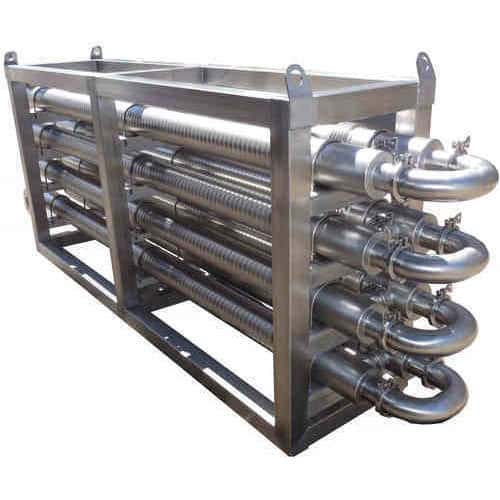
Tube-in-tube heat exchanger specially designed for sludge containing fibers and particles, used for heating and cooling purposes. Tube in tube heat exchangers is introduced with a tube mounted inside an outer shell tube.
During operation, the product medium inside the tube floats into the service medium in counter current. The product tube is folded, or it may be smooth. This unique design prevents thermal fatigue, increases efficiency, and reduces overall size. They are perfect for high-temperature, high-pressure, and low-flow applications.
#3 Double Pipe Heat Exchanger
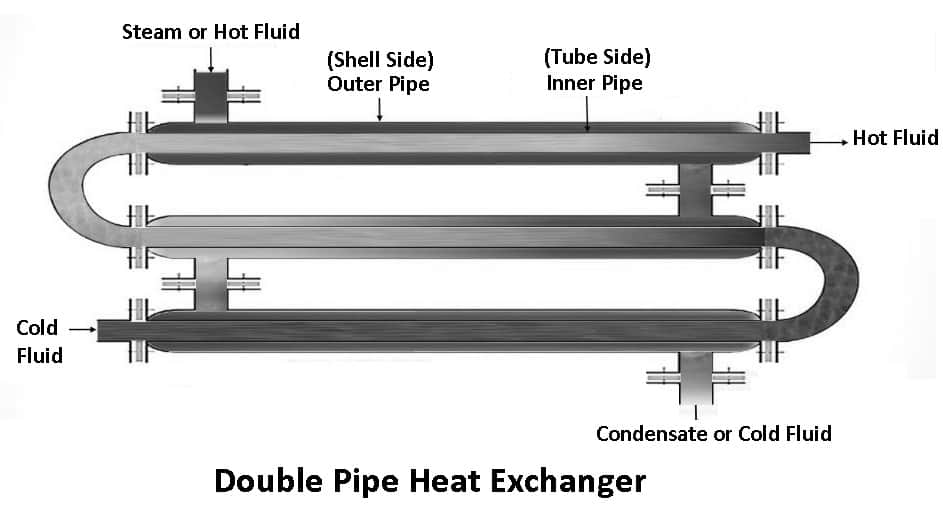
These types of heat exchangers are perfect for the transfer or exchange of heat between two liquids without mixing them. Double pipe heat exchangers consist of two or more concentric, cylindrical pipes or tubes (one larger and the other smaller).
In this, one liquid flows through a smaller pipe, and another liquid flows between the two pipes, and so on. The inner pipe acts as a conductive barrier. It can provide good efficiency with low capital cost and is used in many industrial processes, cooling technology, refrigeration equipment, and other fields.
Read Also: What Are The Different Types of Flanges and Their Applications?
#4 Direct and Indirect Heat Exchanger
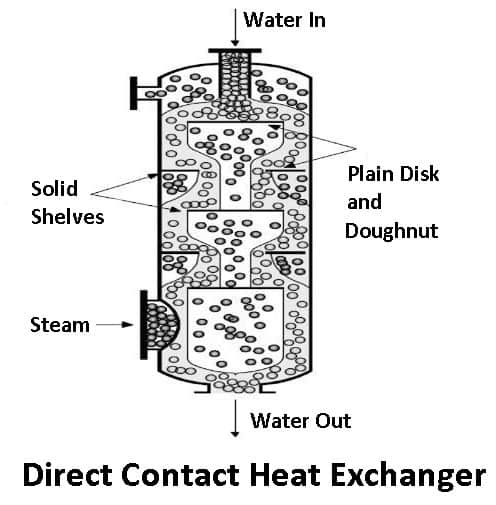
Direct heat exchangers implement heat transfer between two phases of hot and cold currents in the absence of an isolating wall. In these types of heat exchangers, heat exchange is replaced by the direct mixing of hot and cold liquids and the transfer of heat placed simultaneously. Examples include cooling towers and jet condensers.
Indirect heat exchangers are used to measure the change in temperature of one fluid by using another fluid in which the two liquids are separated by an impermeable surface such that the two liquids do not mix. These heat exchangers keep the fluid exchanged heat separated by using tubes or plates etc.
#5 Plate Heat Exchager
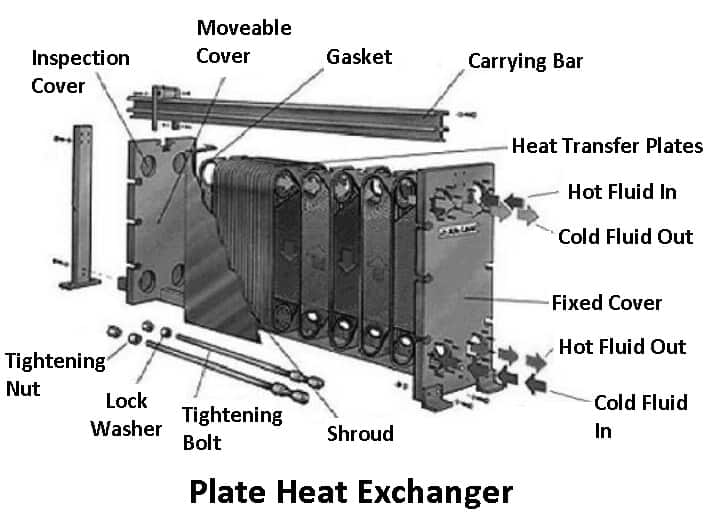
As the name suggests, these types of heat exchangers consist of metal plates. These metal plates form channels through which the interacting fluids can flow. Plate heat exchangers use multiple layers of flat plates fixed to form a series of channels for the flow of fluids.
In this, the heat cuts through the surface, separating the hot medium from the cold one. Thus, heating and cooling liquids and gases use minimal energy levels. They are often more compact and sometimes less costly than shells and tubes. These types of commonly used in water heaters and free cooling.
Read Also: What is the necessity of a sunk key? [Types and Uses]
#6 Pillow Plate Heat Exchanger
These are used for both industrial cooling and heating purposes of products. These types of heat exchangers are fully welded, so they form a wavy, “pillow-shaped” surface by an inflation process. These types are commonly found in reboilers, water chillers, solids drying, etc.
A perfect example of this heat exchanger is commonly seen in the dairy industry for cooling milk in large stainless steel bulk tanks. The tank surface area can be combined with this heat exchanger, without gaps that would occur between pipes welded to the exterior of the tank.
#7 Finned Tube Heat Exchanger
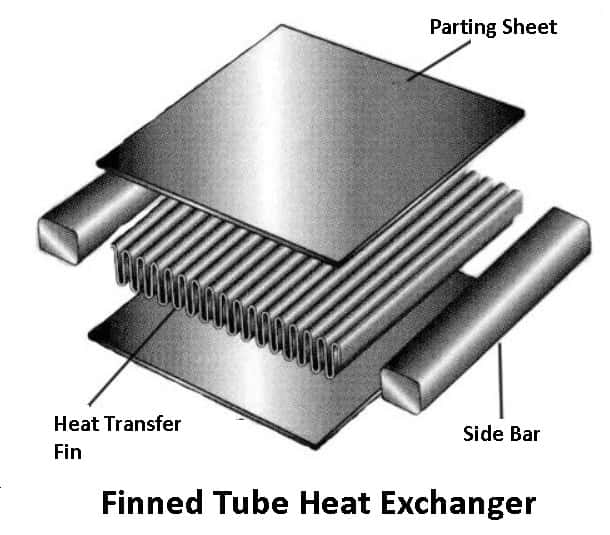
Finned tube heat exchangers are designed to refer to the maximum heat transfer surface area with the exchanged heat, which improves the efficiency of conducting heat in liquids with low thermal conductivity, such as air.
It consists of a series of tubes with fins added to increase the contact area with the external fluid to exchange heat, and between the fluid inside the tube and the fluid outside the tube. These fins are made of either aluminum or copper, which are usually thin. These types of heat exchangers are seen in air conditioners and car radiators.
#8 Adiabatic Wheel heat Exchanger
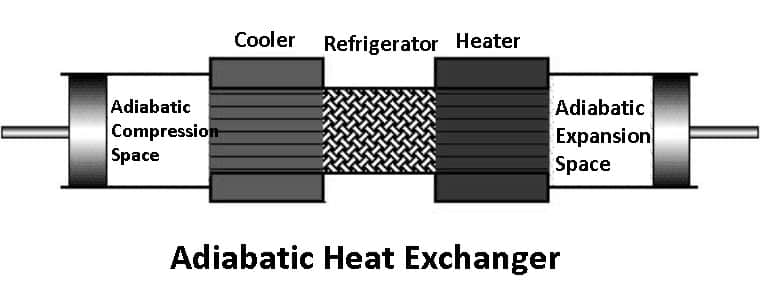
This type of heat exchanger is widely used for industrial purposes. It consists of a rotating wheel and an intermediate fluid that is stored to hold heat. It is then transferred to the other side of the heat exchanger for release.
Threads are provided on the wheel’s circumference to increase the surface area. During operation, it circulates through two sections containing fluid where heat is transferred. These are essential where heat needs to be effectively transferred between gases which is not easily possible in other types.
#9 Phase Change Heat Exchanger
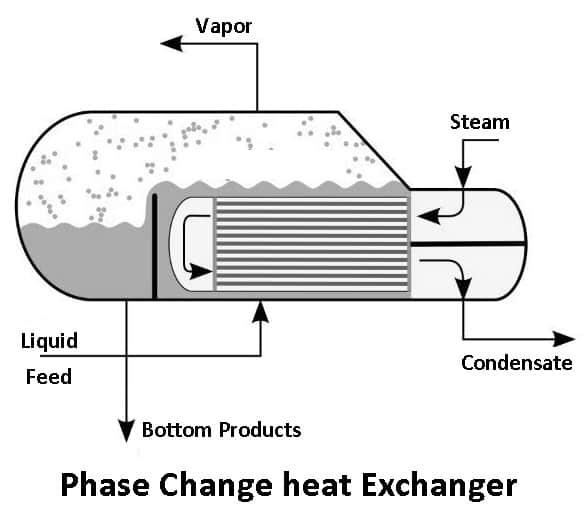
The term “phase” may refer to heat exchangers with the material within their structure in which a change of phase occurs. This heat exchanger utilizes the natural phase-change properties of an environmentally friendly cooling fluid to collect, transfer, and dissipate heat safely and continuously.
It is usually a solid-to-liquid phase due to the small volume difference between these states. This change of phase work like a buffer as it occurs at a constant temperature but still allows additional heat to be obtained. The main advantage of phase change materials is they have the ability to store large amounts of energy.
Read Also: Common Types of Corrosion in Metals [With Examples]
#10 Micro Channel Heat Exchanger
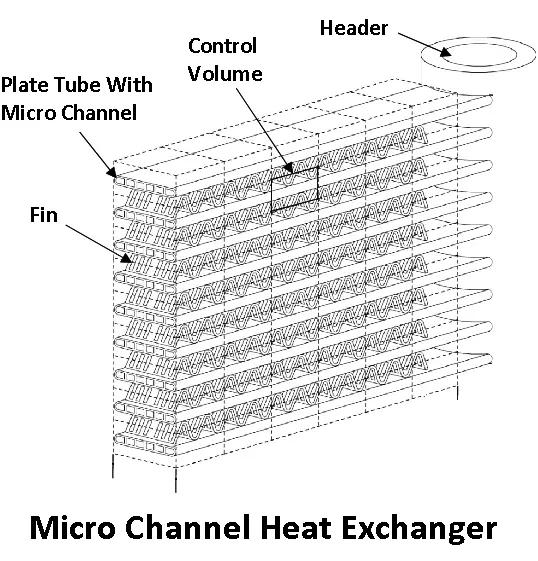
These are types of multi-pass parallel-flow heat exchangers consisting of manifolds (inlet and outlet), multi-port tubes with hydraulic channels (less than 1 mm), and fins. All these parts are usually brazed together using a controlled atmosphere brazing process.
In this type, at least one fluid (refrigerant or water) flows through tubes or enclosed channels while air flows cross-currently through connected fins. They are known for their high heat transfer ratio, compact size, and low airside pressure. Applications in which it is used include the automotive industry as car radiators.
#11 Waste Heat Recovery Unit
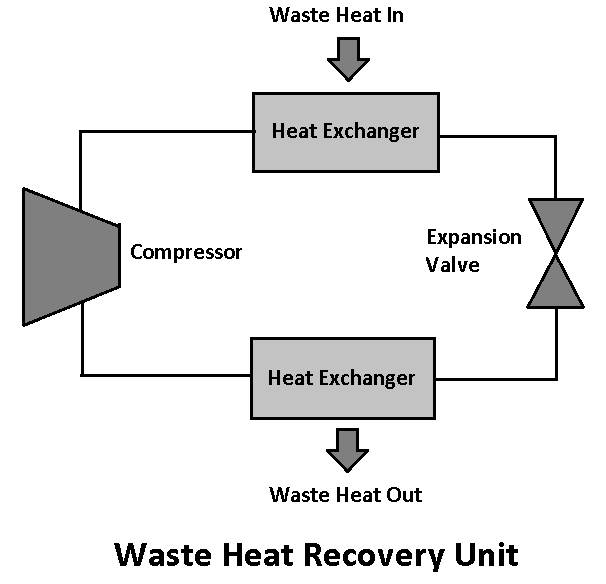
A waste heat recovery unit is also a type of heat exchanger used to transfer heat from the output of the process at high temperatures to another part of the process. A simple example involves domestic drainage heat recovery.
In this method, the heat going down a sink or shower drain is recovered by coiling a copper pipe around the drain pipe. The coil is then used to heat the water as it passes through the pipe on its way to the water heater. These enable companies to reduce waste and increase their efficiency.
#12 Condenser, Boiler, and Evaporator
Many people don’t know this, but condensers, boilers, and evaporators are also types of heat exchangers. These heat exchangers employ a two-stage heat transfer mechanism.
Condensers are heat exchange devices that take hot gas and cool it to the point of condensation, turning the gas or vapor into a liquid. In evaporators and boilers, the heat transfer process is carried out by changing the liquid form from the liquid form to the gas or vapor form.
Read Also: What Are Different Types of Pulleys? [Benefits & Drawbacks]
Heat Exchanger Selection Considerations
There are a number of factors to think about when choosing a heat exchanger. The following are some of the most crucial considerations:
#1 Heat Transfer Requirements
The size and type of heat exchanger are determined by the amount of heat transfer required. The type of fluids used, the temperature range, and the required flow rates will all have an impact on this.
#2 Material Compatibility
The materials used to design the heat exchanger must be suitable for the fluids being transferred. If the fluids are corrosive or abrasive, this is especially crucial.
#3 Operating Conditions
When choosing a heat exchanger, the operating conditions, such as pressure, temperature, and flow rate, must be taken into consideration. Under these circumstances, the heat exchanger must be capable of performing safely and effectively.
#4 Maintenance Requirements
The heat exchanger ought to be simple to keep and maintain. It is important that the design makes it easy for the interior to be inspected and cleaned.
#5 Energy Efficiency
It is important to optimize energy efficiency when designing the heat exchanger. This can be done by picking the appropriate heat exchanger type and customizing the design for the intended use.
#6 Cost
It is essential that you consider all aspects of the heat exchanger’s cost, including both the initial investment and ongoing maintenance expenses.
#7 Environmental Considerations
It is important to think about how the heat exchanger will affect the environment, considering things like the use of renewable energy sources and the disposal of waste heat.
#8 Space Limitations
When selecting the size and configuration of a heat exchanger, it must be taken into consideration the space available for the heat exchanger.
Read Also: Common Types of Welding Defects [Causes, Remedies] Explained
Advantages of Heat Exchanger
- The heat exchangers are normally required fewer maintenance costs.
- These are working at high working pressure and working temperature.
- The perfect-sized heat exchanger can give you an efficiency of around 80%.
- They are simple, easy to maintain, compact in size, and can be easily cleaned.
- Additional space is not required when dismantling.
- Shell and tube heat exchangers are less expensive than plate-type heat exchangers.
Disadvantages of Heat Exchanger
- The main drawbacks are leakage and pressure drop in the system.
- In the plate type, the initial cost is high because titanium plates are expensive.
- The operator has to be careful when dismantling and assembling.
- Over-tightening of the clamping bolts increases the pressure in the cooler.
- The capacity of the tube cooler cannot be increased so this is also a drawback.
Application of Heat Exchanger
- Mainly, heat exchangers are used for transferring heat from one medium to another.
- They are also used to preheat a cold fluid entering a hot process system by using heat from the hot fluid exiting the system.
- Shell and tube-type heat exchangers are used for various industrial purposes.
- The spiral heat exchanger is good for applications such as digester heating, heat recovery, and effluent cooling.
- These are typically used to heat food and cool beverages.
Wrapping It Up
Heat exchangers are types of equipment used to transfer heat from a hot liquid to a cold liquid. They are considered useful for performing the function of changing the temperature of the more valuable liquids used in the process.
So now, I hope I’ve covered everything about “types of heat exchangers“. If you still have any doubts or questions on this topic, you can contact us or ask in the comments. If you like this article then please share it with your friends.
Want free PDFs sitting at home? Then subscribe to our newsletter.
Download PDF of this article:
You might like to read more in our blog:
- What is Boiler Draught? [Advanatges & Disadvantages] PDF
- Definition and Types of Heat Treatment Process [Complete Guide]
- How Extrusion Process is done in manufacturing?
External Links:
Very nice information keep it up.
Thanks for reading.